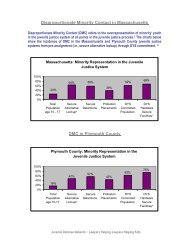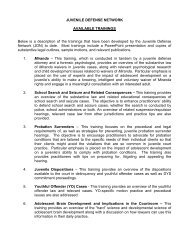States rethink 'adult time for adult crime' - the Youth Advocacy Division
States rethink 'adult time for adult crime' - the Youth Advocacy Division
States rethink 'adult time for adult crime' - the Youth Advocacy Division
Create successful ePaper yourself
Turn your PDF publications into a flip-book with our unique Google optimized e-Paper software.
Pennsylvania man who was facing <strong>the</strong> death penalty <strong>for</strong> crimes committed as a juvenile.<br />
I happened to have reviewed this literature <strong>for</strong> a manuscript reporting our own data<br />
from longitudinal studies per<strong>for</strong>med by Penn’s Brain Behavior Laboratory and <strong>the</strong><br />
Schizophrenia Center, and so I agreed to augment it and make it more readable <strong>for</strong> nonexperts.<br />
He sent it back to me, this <strong>time</strong> <strong>for</strong>matted as an affidavit in <strong>the</strong> case of a Mr.<br />
Hector Huertas. He asked whe<strong>the</strong>r I would mind reviewing <strong>the</strong> affidavit and, if I agreed<br />
with its contents, to notarize and sign it. Well, I agreed and it apparently worked. The<br />
Commonwealth decided not to pursue <strong>the</strong> death penalty in light of scientific findings<br />
that <strong>the</strong> brain does not mature until early <strong>adult</strong>hood. Soon afterward Mr. Bookman<br />
called again, this <strong>time</strong> to help a colleague in Texas who was defending a Mr. Toronto<br />
Patterson, a death-row inmate who also committed his crime when he was an<br />
adolescent.<br />
The affidavit did not save Mr. Patterson’s life, but while <strong>the</strong> U.S. Supreme Court refused<br />
to hear <strong>the</strong> appeal, it expressed interest in <strong>the</strong> scientific evidence from brain research<br />
that was presented in <strong>the</strong> case, and invited such arguments in future cases. The race was<br />
on to see what would be <strong>the</strong> test case determining whe<strong>the</strong>r <strong>the</strong> death penalty will apply<br />
to juvenile defendants, and I found myself being asked to sign affidavits from around<br />
<strong>the</strong> country. The “winner” was a Missouri man, Mr. Christopher Simmons (Roper v.<br />
Simmons). Below is a summary of <strong>the</strong> material I have submitted as part of an amicus<br />
organized by Mr. Simmons’ defense:<br />
The rate at which <strong>the</strong> human brain matures has been of considerable interest to<br />
neuroscientists, and knowledge of when different brain regions mature in human<br />
development may have profound implications <strong>for</strong> understanding behavioral<br />
development. Although <strong>the</strong> brain and its structure become well differentiated during<br />
fetal development, <strong>the</strong>re is overwhelming evidence that much of <strong>the</strong> maturational<br />
process occurs after birth. Indeed, projections from early pioneering work on donated<br />
brain tissue have indicated that some brain regions do not reach maturity in humans<br />
until <strong>adult</strong>hood. These projections have been confirmed by more recent neuroimaging<br />
studies.<br />
While sophisticated methods <strong>for</strong> preservation and dissection of postmortem brain tissue<br />
had been developed in <strong>the</strong> first decades of <strong>the</strong> 20th century, it was not until <strong>the</strong> 1960s<br />
that enough such tissue was available to examine <strong>the</strong> question of brain maturation in<br />
humans. Arguably <strong>the</strong> largest collection and <strong>the</strong> most influential work was that of Dr.<br />
Paul I. Yakovlev and his colleagues at Harvard University. His work has focused on <strong>the</strong><br />
creation of myelin, fatty tissue surrounding nerve fibers. This process, known as<br />
myelogenesis, is important <strong>for</strong> assuring efficient transmission of neuronal signals;<br />
myelin surrounds <strong>the</strong> nerve fibers that carry in<strong>for</strong>mation across large distances very<br />
much in <strong>the</strong> same way that rubber is used <strong>for</strong> insulating cables designed to conduct<br />
electricity across distance.<br />
Yakovlev examined slices of brain tissue from a wide age range of more than 200 brains,<br />
finding that especially late to myelinate were those parts of <strong>the</strong> brain that inhibit and<br />
modulate <strong>the</strong> more primitive, drive-related activation of <strong>the</strong> limbic areas. As interpreted<br />
by Yakovlev and his colleagues, <strong>the</strong> anatomic data indicated that <strong>the</strong> very functions that
















